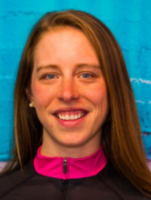
Diane is currently a Ph.D. candidate at the University of California, Davis in geotechnical engineering working under professors Ross Boulanger and Jason DeJong. Her research numerically studies cone penetration in intermediate soils as part of a collaborative effort to develop unified CPT interpretation methods. Additional research interests include geotechnical characterization of unique materials such as mine tailings, volcanic ash, or coal fly ash, and developing geotechnical analysis tools for underground construction. Diane earned a Bachelors degree in geological engineering from the University of British Columbia in Vancouver, BC, after which she spent 3 years as a consulting engineer and hydrogeologist at Robertson GeoConsultants (RGC). Her projects at RGC included geotechnical and hydrogeological characterization and analysis of unique materials including polymer treated oil-sands tailings, mine tailings storage facilities, and volcanic ash deposits. Diane has held leadership positions for the Geotechnical Graduate Student Society at UC Davis (GGSS) including President and Outreach Coordinator, and as the Co-President and Treasurer of the Earthquake Engineering Research Institute’s Student Leadership Committee (EERI SLC).
Correlations of cone penetration test (CPT) measurements to geotechnical soil properties have been well developed for clean silica-sands and sedimentary clays. However, CPT correlations that directly address intermediate soils, such as clayey sands, sandy silts, non-plastic silts, are often not theoretically informed, and furthermore these soils are not well represented in case history data-bases for empirical correlations. These gaps in engineering practice are addressed through a mechanics-based framework to develop correlations between CPT data and engineering soil properties. The framework develops a liquefaction triggering correlation for cone tip resistance (qc) and cyclic resistance ratio (CRR) by convolving (1) a numerically derived qc, relative density (qc-DR) relationship, and (2) an experimentally derived DR-CRR relationship; the correlation is then validated with geotechnical centrifuge experiments.
A direct axisymmetric cone penetration model in the finite difference platform FLAC addresses the numerical component of the framework. While direct penetration simulations can capture the complex loading conditions around the penetrating cone across intermediate soil types, large model deformations around the cone face and cone shoulder must be addressed. Large deformations are accommodated with a user-defined Arbitrary Lagrangian Eulerian (ALE) algorithm that performs rezoning and remapping operations with the Corner Upwind Transport scheme (Colella, 1990). The model is implemented with the MIT-S1 constitutive model (Pestana and Whittle, 1999) and validated for penetration in Boston Blue Clay and Ottawa Sand. The framework is applied with Ottawa Sand to develop a qc-CRR correlation for clean silica sand which can be validated with empirically-based liquefaction triggering relationships (i.e. Boulanger and Idriss, 2014). The validated framework provides a basis for characterization of intermediate soils, unique soils (e.g. mine tailings, coal fly ash, volcanic ash), and non-uniform soil deposits.
Lindsay Walton
(858)822-3273
lwalton@ucsd.edu
